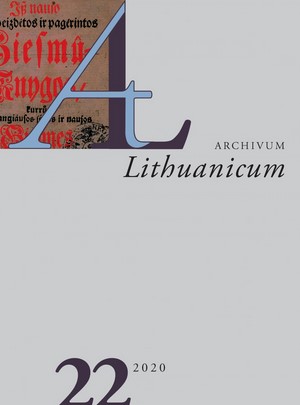LIETUVIŲ TARMIŲ SAMPRATA POVILO FRYDRICHO RUIGIO GRAMATIKOJE ANFANGSGRÜNDE EINER LITTAUISCHEN GRAMMATICK (1747): CENTRAS IR PERIFERIJA
THE CONCEPT OF LITHUANIAN DIALECTS IN PAUL FRIEDRICH RUHIG'S GRAMMAR ANFANGSGRÜNDE EINER LITTAUISCHEN GRAMMATICK (1747): CENTER AND PERIPHERY
Author(s): Ona AleknavičienėSubject(s): Theoretical Linguistics, Lexis, Historical Linguistics, Baltic Languages, 18th Century
Published by: Lietuvių Kalbos Institutas
Keywords: Paul Friedrich Ruhig; Grammar book; Prussian Lithuania; Lithuanian language; Lithuanian dialects; primary and secondary; language norms;
Summary/Abstract: Paul Friedrich Ruhig’s (Ruhigk, ~1721–~1784) grammar Anfangsgründe einer Littauischen Grammatick (1747, RG) is the fifth Lithuanian grammar book of Prussian Lithuania. It was written by a very young man (in 1747 he was probably around twenty five years old) who came from the famous Ruhig family, known for its work with the Lithuanian language. Ruhig wrote the grammar while working as a Docent in the Lithuanian Language Seminar that was established in 1718 at the University of Königsberg’s Theology Department. He based his writing on earlier grammar books and on his own pedagogical experience. Ruhig’s Grammar is primarily intended for those attending the Lithuanian Language Seminar. The aim of this article is to determine how Ruhig understood Lithuanian dialects, how he defined their territories, and how he explained some particularities differently than authors of previous grammar books. The article will also pay attention to some of the inaccurate interpretations of this work in contemporary linguistic studies. The research addresses several aspects: 1) territorial—spread of variations; 2) markedness—distinctiveness related to other variants; 3) normative—the relationship with written language. The article first provides an overview of dialects as an object of Lithuanian language research from the 17th–18th centuries, then turns to Ruhig’s concept of dialects, their categorizations and linguistic particularities. The research seeks to determine the sources that he used and how original, how substantiated, and how acceptable are his conclusions.
Journal: Archivum Lithuanicum
- Issue Year: 2020
- Issue No: 22
- Page Range: 83-130
- Page Count: 48
- Language: Lithuanian

